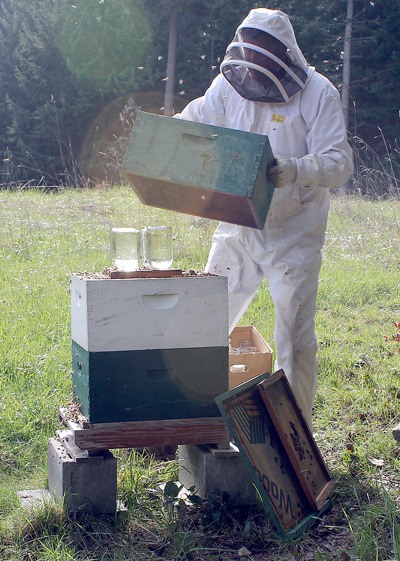Todd Peterson’s girls have become unusually early risers.
The longtime Whidbey beekeeper leaned against his truck and glanced at the pile of wooden boxes neatly stacked in the sunny yard of his old farm.
The boxes contain a beehive, home to a colony of about 12,000 of Peterson’s bees, which he affectionately addresses as his “ladies.”
The bees don’t leave the hive until the temperature is at least 50 degrees, though they prefer it to be warmer. On Thursday afternoon, an audible buzz emitted from the hive as several of the insects clustered around its entrance and others ventured off a ways, perhaps in search of food.
It’s the earliest Peterson has ever seen them rising from their winter rest. Though bees don’t hibernate, they remain clustered together in order to maintain a hive temperature of about 90 degrees throughout the chilly winter.
The colony is one of four Peterson tends to on the island. All are honeybees, annually producing a rich and nutritious golden treat for Peterson, his friends and family. Depending on which plants the bees frequent for pollination, their honey will produce distinct flavors and variations in color. On Whidbey, the most popular strain of honey is blackberry.
According to the Natural Resources Defense Council, honeybees’ cross-pollination helps at least 30 percent of the world’s crops and 90 percent of wild plants to thrive and produce food.
“They’re fascinating creatures…extremely industrious and beautiful,” Peterson said. “They read the world in a way that I can’t.”
“There is so much in our world that is unpredictable and chaotic,” he added. “The bees are productive and energetic and that is good to be around.”
Peterson began beekeeping about 30 years ago. At around the same time, beekeeping pioneers Dan and Judy Harvey moved to a remote area of the Northern Olympic Peninsula.
Soon thereafter, the Harveys began their research into the unique area honeybee population rumored to have survived despite the drastic decrease in the bee populations internationally and their work to breed “survivor bees.”
On Wednesday, the Harveys visited the Freeland Library to present their research to a packed room of Whidbey bee enthusiasts, including about 30 members of the island beekeeper group, Whidbees, of which Peterson is a part.
Audience members listened intently as Dan Harvey spoke of his findings and his progress. Like Peterson, the majority of Whidbees’ members are greatly concerned with the survival of their most beloved insects.
Sooja Nehrlich, a Whidbees member, said she joined after reading about the struggle of honeybees worldwide.
“I wanted to do my part providing a healthy environment for them,” Nehrlich said.
Kathy Maxwell, also a member and wife of club president Dan Maxwell, wrote in an email to The Record that her husband also takes great pride in caring for “his girls.”
“I know it is with great affection even if they do take an intense and rather stinging dislike of him,” Maxwell, who is currently away in Arizona with her husband, wrote.
Honeybee deaths, which peaked in the early to mid 2000s, were due in part to widespread Colony Collapse Disorder, as well as the infestation of mites, including varroa destructors. Though Asian honeybees had developed a resistance to varroa mites, European honeybees had not.
Several other issues such as new forms of bacteria and pathogens and habitat decline further contributed to the devastation of colonies.
Harvey has been working extensively to breed survivor bees, resistant to mites, pathogens and bacteria. His hives are unmedicated, meaning that he uses natural methods of preventing infestations and contamination. He surmises that the unique survivor bees of the Olympic Peninsula were the descendants of bees early 20th-century homesteaders had ordered from the Sears and Roebuck catalogue. Many of these bees were from Eastern Russia, and likely developed a resistance to mites similar to the Asian honeybees.
Harvey interbred them with SMR, or suppressed mite reduction bee stock, which had been developed by the USDA in the 1990s due to their hygienic behavioral characteristics (they immediately clear out any larvae in the hive which they determine to be sickly or deceased).
Due to the invasion of new problems such as the virus Nosema, the Harveys have experienced several setbacks, but they have also made great gains. In 2012, a study from Denmark determined that, after careful breeding, Danish bees had developed a resistance to the virus Nosema.
Since 2012, the Harveys have only experienced a 10 percent loss in bees each year, compared to a 90 percent loss from 2007-2011, and are working with researchers and national laboratories to further strengthen their stock.
The Harveys instructed attendees on ways to inspect the health of their own hives and offered information as to purchasing queens bred from survivor stock.
For beekeepers like Peterson, the Harveys offered the ultimate encouragement. Though he said it is impossible to know whether the bee population can be bolstered to its pre-2000s number, Peterson said he is confident that the number will increase with proper care and continued study.
“It’s a window on the natural world,” Peterson said. “The bees tell you about what’s going on in nature.”
For more information on Whidbees, email sooja@whidbey.com or visit the group Facebook page.



